Living Life Fully with Your Ostomy – Part 3: Practical Habits
I walked as carefully yet as quickly as possible down the aisle of the darkened airplane, trying not to make any noise that would awaken the sleeping passengers. Those who weren’t quite asleep must have thought they were dreaming, as I stumbled past, my hands clutching my pants somewhere between my knees and my upper thighs. At that moment, I wished I was dreaming, but knew I wasn’t.
I had boarded the redeye international flight several hours ago, slept restlessly for a couple of hours, and then woken up to realize that my ostomy bag was inflated to maximum size. In my sleepy stupor, my only thought was, “This thing is gonna pop!”
After a few minutes of trying to decide what to do, I unbuckled my belt and pulled my pants down to avoid putting unnecessary pressure on the bag. Then, I gingerly got out of my seat and started making my way towards the nearest bathroom. Thankfully, I made it without any explosions, and with only a few confused stares from bewildered passengers.
If you’ve been wearing an ostomy bag for a reasonable amount of time now, you know that you have three main enemies: heat, moisture and gas. The primary goal of these enemies is to create leakage of the contents of your bag – be they solid, liquid, or gas – thereby causing inconvenient, awkward, and sometimes downright embarrassing situations (see Part two, as well as Part one of this series).
You can work against these enemies by creating and following certain routines to keep your equipment functioning properly. In the situation described above, gas from my own digestive system was the culprit. As the gas built up inside my ostomy bag, it tested not only the strength of the bag, but more importantly, the effectiveness of the seal between my bag and the flange and the flange and my body (I have a 2-piece system).
Now, whenever my travel involves elevation changes – especially by airplane but even on mountain roadtrips – I set a timer if I’m sleeping to check my bag every few hours or so in order to release the pressure and avoid a repeat of the transcontinental trauma I mentioned earlier. When it comes to regular, daily life, I’ve noticed a consistent rhythm – the mornings are quiet and not very active in terms of “output” (gas, liquids and/or solids) from my ostomy into the bag. The period of time from after lunch until the evenings are the opposite: more noisy and ‘productive’, if you will.
Please note: this rhythm may or may not be the same for you. The point is to notice and take your body’s rhythms into account when considering various activities that you might be involved in.
On a day-to-day, week-to-week basis, I have learned by trial and error to change my flange every 4 days, while my bag works optimally when I hook up a new one every week and a half. If my ostomy gear has been exposed to more heat and moisture than usual – perhaps it’s summer and I’ve been swimming a lot, or I’ve been doing yard work and perspiring more heavily – I’ll take those things into account and install new equipment much earlier than usual.
It will take time to understand your own rhythms as well as the ideal lifespan of your equipment. But with greater personal awareness (vitamins/ supplements such as Metagenics and Progressive), access to quality ostomy supplies, and the support of trained specialists (like the ET nurse I described in Part 2), you will figure out your own habits and routines to help minimize your ostomy-related incidents and live your life more actively and confidently.



